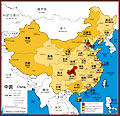
While top Chinese global cities attract significant business activities, they score lower in political engagement relative to their counterparts in North America and Europe. New Delhi, which improved slightly from 57 in 2015 to 56 in 2020, is the exception. There has also been a downward trajectory in their rankings from 2015-2020. India, which also experienced tremendous economic growth over the past few decades and is roughly as populous as China, saw fewer new global cities emerge. Outside of big cities, lesser-known cities, such as Shenzhen, Guangzhou, Hangzhou, Ningbo, and Suzhou, have considerably grown their global influence given their roles in the Chinese and world markets. Additionally, Shanghai and Hong Kong are global leaders in sea and air freight respectively, and Hong Kong ranks first in the world in terms of Initial Public Offering (IPO) proceedings, many of which are for mainland Chinese companies. Shanghai and Shenzhen are each home to another 7 percent of Chinese Fortune Global 500 companies. Over 43 percent of the 124 Chinese companies included in the 2020 Fortune Global 500 are headquartered in Beijing. Some of China’s global cities, such as Beijing, Shanghai, and Hong Kong, have traditionally served as hubs of economic activities, and they remain dominant today. The average ranking of cities in other top-five countries declined to different extents between 20 (from 28 to 31 in the US 81 to 91 in India and 78 to 98 in Brazil).Ĭhinese cities owe much of their global influence to high levels of business activity. Among the five countries with the largest number of global cities, only Germany showed similar improvement (from 38 in 2015 to 33 in 2020). In 2015, the average ranking of a Chinese global city was 93. Notwithstanding the lower ranking, the global influence of Chinese cities has trended upward over the past six years. While there are more global cities in China, on average a global city in China ranks lower (82) compared to those in other countries (31 in the US or 33 in Germany). 2 The US came in second with 14 cities and India came in third with seven. In Kearney’s 2020 GCI, 18 Chinese cities ranked among the top 125 global cities. Top Countries in the Kearney Global City Index (2020)Īs countries with larger populations typically boast a higher number of urban centers, it is unsurprising that the most populous countries – China, India, and the US – have the greatest number of global cities. 1 The composite ranking reflects the relative influence of a city on the world. Based on 29 indicators, Kearney evaluates each city’s performance in five areas: business activities, human capital, information exchange, cultural experience, and political engagement. International consultancy Kearney ranks cities around the world in its annual Global Cities Index (GCI). The global influence of Chinese cities has expanded over the past decades. As a result, cities have become one of the main gateways through which China interacts with the world. International companies have also set up offices in different cities to better access China’s vast market. In addition to domestic population movements, the growth of Chinese cities has drawn travelers, students, and workers from other countries. In 2011, more than half of all Chinese citizens lived in cities for the first time in history, and by 2020 the urbanization rate in China stood at 61.4 percent.


In 1979, only 18.6 percent of the Chinese population resided in urban areas. The employment opportunities brought by Chinese economic reforms launched in the late 1970s led to a surge of people moving out of rural areas and into cities. As China has rapidly developed in recent decades, historically prominent Chinese cities such as Beijing and Shanghai have grown in international influence, and many new global cities like Shenzhen have emerged as increasingly significant players in global commerce. Countries with more global cities can thus better benefit from the international flow of capital and talent. “ Global cities” are particularly critical nodes within the international economy, as they provide specialized services, such as finance, and serve as hubs for innovation. Cities are key centers of economic, political, and cultural activities. Since 2009, a greater proportion of the global population has lived in urban areas than in rural areas.


 0 kommentar(er)
0 kommentar(er)
